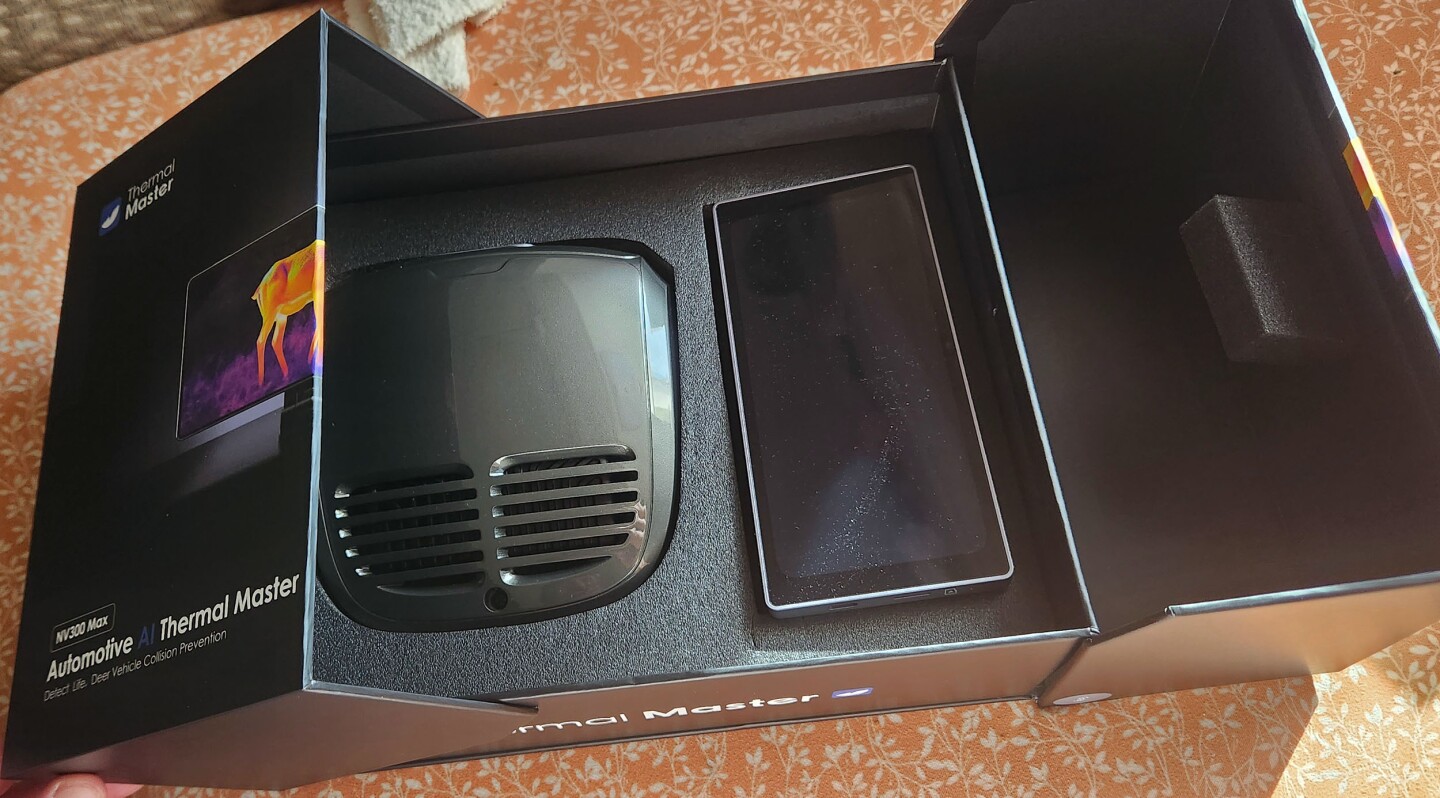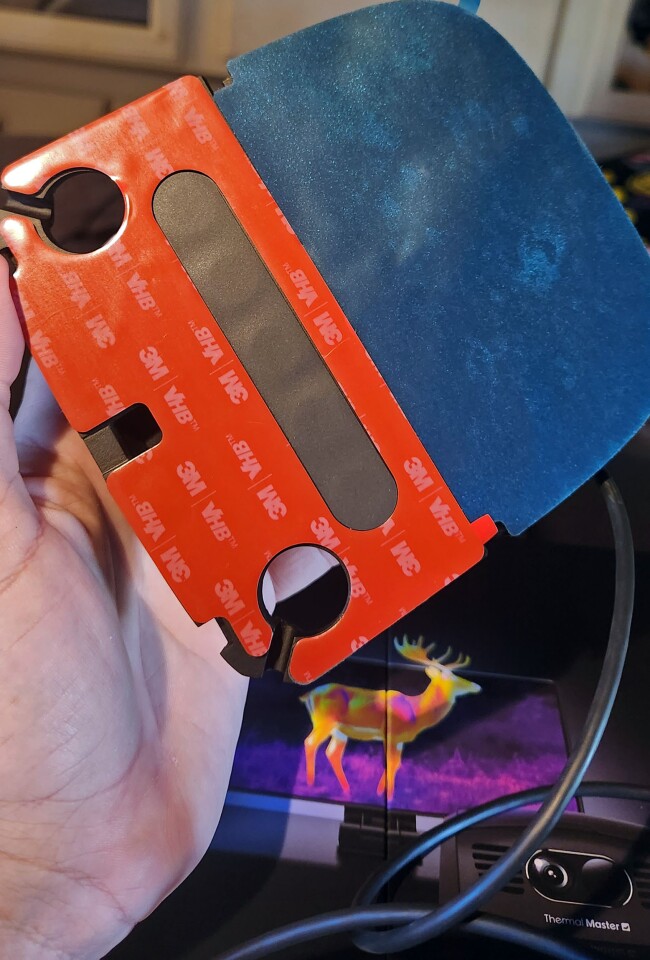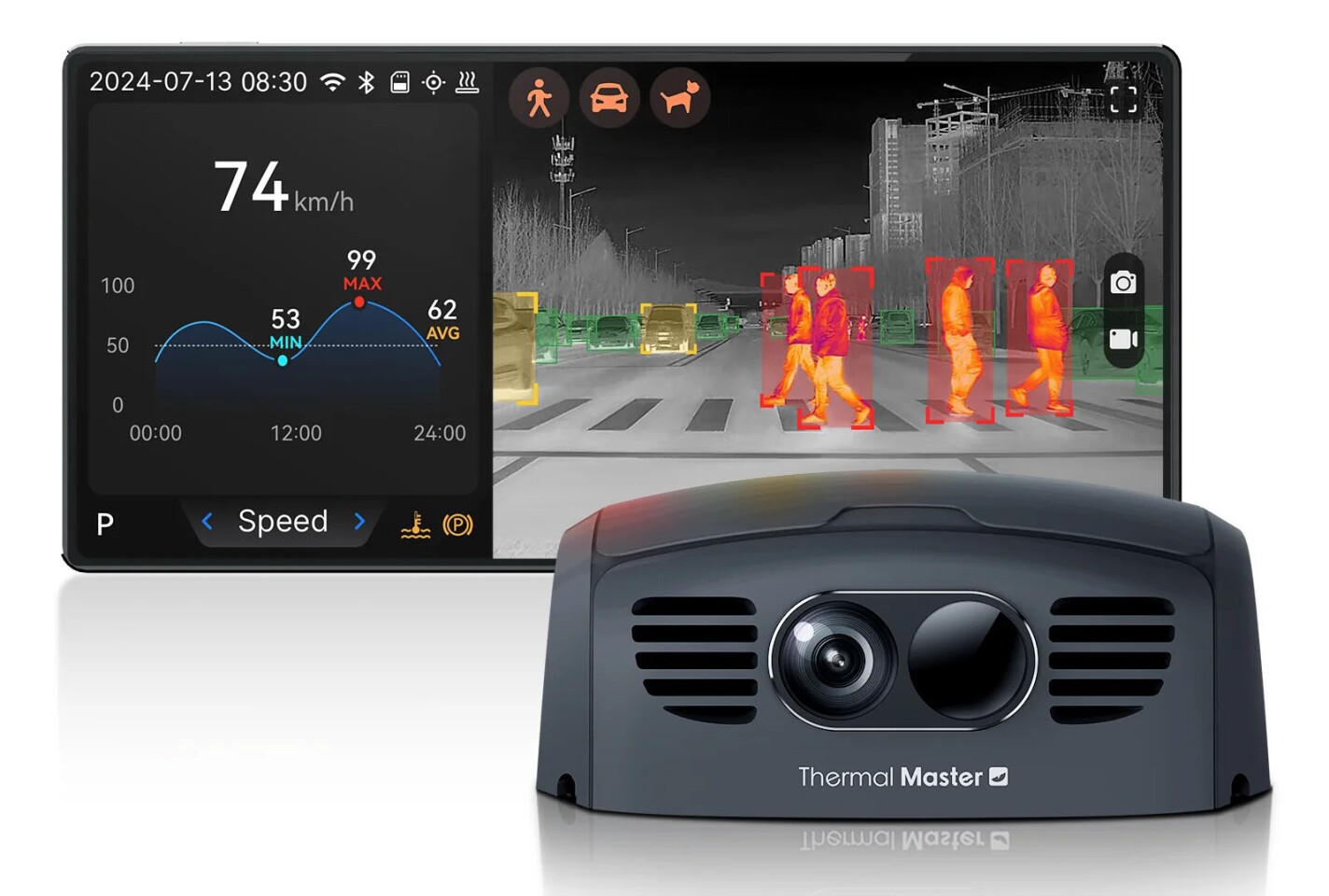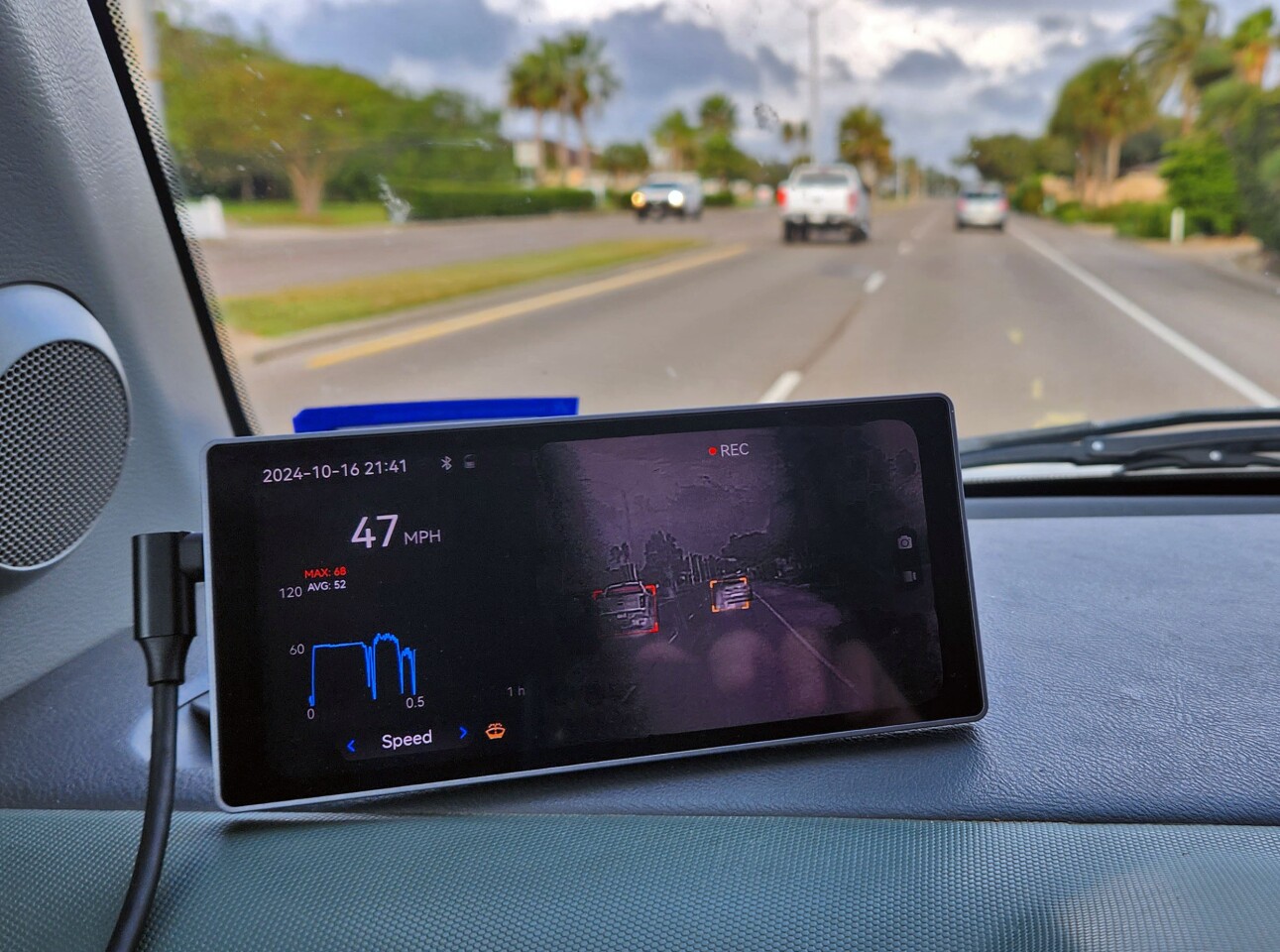
The guys over at Thermal Master sent us its new NV300 thermal imaging unit for your car to give it a thorough test and a review. Here are my thoughts: A thermal imaging dash cam is pretty darn tootin’ cool … The NV300 just misses the mark though.
The end will have my pros and cons and final thoughts. The rest is musing of my experience. I also included a lot of unedited pictures taken right from the microSD card in the gallery.
Musings after weeks of tinkering:
As a user of dashcams over the last decade or more, I’m a firm believer that everyone should have one. In my millions of miles of driving all over the country and then some, I’ve seen my fair share of outlandish maneuvers by drivers that would not qualify for a Formula 1 race, though they may think they can. More than once, I’ve turned over video evidence to law enforcement from collisions I’ve witnessed. Dashcams have also saved me from tickets when I’ve been able to prove my GPS data-logged speed and location.
I also have an entire compilation of videos over the years that I call « Animals trying to die » on my hard drives from (usually) night-time critters throwing themselves at my car while I drive through remote deserts or forests. Usually, I see them just in time to decide « Can I eat it in one sitting? No, okay, must evade and avoid » before putting my many years of racetrack experience to use and slip, slide, and swerve around these apparently suicidal animals. Deer, bears, coyotes, dogs, cats, raccoons, owls, people … I could go on with the many creatures of the night that have flung themselves solidly into the crosshairs of my little square SUV with zero driver aids like ABS or traction control.
I have a 99.9% avoidance rate so far, albeit with lots of tire squeals and smoke and choice expressions like « whooo baby! », but I’m a lover of animals and I don’t want them to die. I still have nightmares from that one raccoon …
Dashcams should be required on all vehicles. If anything, for the stories.
When I received Thermal Master NV300, the first thing I noticed was how big the package was. It was nearly twice the size of a shoebox. As I began to unbox it, I was pleasantly surprised that it was not as big as the packaging implied, it was simply packaged well, giving it a high-end quality feel. That’s where my pleasant surprises ended, however.
The system is comprised of three parts: The camera unit (which contains an infrared camera (IR) as well as a standard wide-angle camera) and screen with all the necessary cabling, and the Bluetooth OBD-II module. It comes with a Phillips screwdriver (which you’ll need), a small magnet (which I assume is to help you locate the tiny screws you’re likely to lose while installing the camera), and several adhesive-backed cable organizers.

New Atlas
As this was an early unit, I received no documentation for it. I fully expect units shipped to customers will have full documentation. First things first was to plug everything in and simply set the camera on my dash. Then I realized I was going to have to take the camera unit apart to run the power cable into it. After fiddling with that for 15 minutes (heads up, there are two power cables that will fit into the camera. Use the « L » cable on the camera side), I was ready to install.
The OBD-II dongle didn’t fit very well. I had to force it halfway in as the center blade was simply milled too wide for my Honda. As I do all of my own work on my vehicles, I happen to own an OBD-II reader which I’ve used across many vehicles, so I was very familiar with the process, as well as the issue with the supplied Bluetooth dongle.
Within minutes, I had the pigtails connected to the power and it booted right up. I was greeted by a split-screen image of a pretty wide field of view (FOV) camera angle on the right, and a speedometer in metric units on the left.
I installed the Android app onto my highly modified Galaxy S22 and tried to connect to the NV300. Try as I might, I could not. I grabbed the wife’s bone-stock Pixel 7 with the same results. I could not connect to it with the app. I reached out to Thermal Master in hopes of figuring it out, but in the end, I could not. The entirety of my test with the NV300 was done without support from the app.
Being a pretty techy guy, I immediately started doing all the things in my repertoire as there were no indications of where buttons, functions, or settings might be on the NV300 screen. Like GoPro’s more recent cameras, If you swipe down, you can access recordings. I found that pretty fast. Check. If you tap the speed, it’ll switch from KPH to MPH. Check. If you swipe left from the right-hand edge of the screen, it’ll switch viewing modes. Auto, visible light mode, « Fushion » mode (fusion, I think, but it’s written as ‘fushion’ on screen), split-view (of both visible light and infrared) and thermal. Check. By default, thermal mode is set to « white-hot. »
The visible light camera performed excellently when looking at the screen. I was impressed by its wide FOV and it could see nearly from A-pillar to A-pillar while centered on my dash. However, the IR camera simply showed black.
It was then that I realized that IR doesn’t work through glass. The unit was going to have to be mounted externally. I decided it would have to wait a day or two when I could set aside an hour or so to mount it properly. The bottom of the camera unit is covered in about 47% 3M sticky tape. That means it’s going to be permanent. This requires a plan.

New Atlas
The next day, I mocked it up on the roof of my SUV. The camera has magnets in it, but didn’t have a strong enough pull for me to be confident that it wouldn’t get blown off at freeway speeds over a bump, perhaps losing an expensive product meant for review. I quickly realized that the IR camera FOV was quite narrow at 25 degrees wide, so aligning the unit correctly is paramount. I decided to offset mine to the right to minimize the amount of cabling on the roof of my car. I pulled back the adhesive backing and held my breath as I lined it up, no going back now … THWUMP. The magnets pulled the unit out of my hand and onto my roof. Thankfully, by the grace of the thermal imaging gods, it landed almost exactly perfect.

New Atlas
I spent an hour or so routing wires under trim pieces, through the passenger door, and behind my dash on the passenger side. I mounted the screen at the bottom of my driver-side A-pillar. The screen mount is more 3M sticky tape but with a nice magnetic stand that the screen sticks to wonderfully. Thermal Master provides PLENTY of cable, so it should fit in nearly any vehicle. There are about 6 feet rolled up in my glove box that I’m not sure what to do with yet.
My first time driving with the NV300 was actually fun. I made a game of « What will it spot before I do? » It was difficult to not watch it in « Fushion » mode, as it would bracket anything it suspected of being a living creature – very much like a Yautja from Predator. The AI would give it a quick thought before yelling « HAZARD! » at me and lighting up the offending object in an orange glow. Whether it be a person walking down the sideway, a bicyclist riding down the bike lane, a construction barrel on the side of the road, a light post, a street sign, or even once a lighthouse on an island about 3/4 of a mile away as I drove across a causeway, the NV300 never failed to verbally warm me with « HAZARD! »

New Atlas
It was days later before I found – and quite by accident – how to access the settings menu on the NV300. I grabbed the screen by the lower right corner, with my thumb having inadvertently clicked the hidden menu button. I also discovered it has voice commands! Just say « Hi, Max » to the screen and viola, you’ve got about 30 commands at your disposal. Most of which are « set the brightness/volume to… » with increments of ten percent.
As quirky as the NV300 is, I shall refer to it as Max from now on.
With everything being a hazard and now having access to the settings I tried again to connect it to Wi-Fi and Bluetooth to no avail. The SSID « nv » simply does not exist, even if I manually force those settings in my phone, I got nothing. I also turned off all sounds except for animal warnings. Max had an annoying habit of telling me every car at every red light was a hazard as I slowed to take my place in red-light-hell queue. Even the slowest, most gradual approaches to the stopped vehicle in front of me while doing sub 5 mph would result in Max accusing me of being a inattentive driver. At least, that’s how it felt.
With the sounds off, and glancing at the screen while driving at night started being fun again. The game I’d mentioned of « What will it spot before I do? », I was very much in the lead. Max had only a single point in the many, many hours of night driving I’d done over the weeks. Max spotted a pair of bicyclists on the opposite sidewalk almost a block away that I hadn’t seen. Max likely saved their lives that night. At least that’s what I tell Max. *Edit – the night I wrote that, Max scored two points in a row as I drove to the store.
I took my little SUV through the automatic car wash since installing it on the roof. The NV300 is IP69K rated, which means it’s the best of the best in terms of waterproof and dustproof. The NV300 didn’t skip a beat. Though, being externally mounted means it’s subject to bug splats, dirt, and weather affecting its visibility; you can’t just turn your wipers with a spritz of washer fluid to clean it up. In fact, turning on your washer/wipers creates a whole new issue of needing to stop and wipe off the lenses of the NV300.
As I’ve never been able to connect the app, nor have I received a proper user manual, there are icons on the screen that I’m not sure what they’re for. One is a persistent yellow icon that popped up after a few days that I assume means low washer fluid … But my washer fluid is full … And my SUV doesn’t have a sensor to alert me when it’s not.

New Atlas
Pros and cons:
- It can see in total darkness, or even through bright oncoming headlight glare, though the screen is too small and lags slightly and often freezes for a moment to be of any real use in real-time.
- The NV300 warns you of potential danger to almost a thousand feet (300 meters) away regardless of how much light or fog there is, though most of the time, it’s usually a sign or a street light.
- As long as it has power, it records continuously, deleting old footage that isn’t manually saved or saved as an « emergency file », though, both cameras are fairly low resolution. The IR camera is VERY low resolution at 256×192 @ 12um, so don’t expect any details, whatsoever. The visible light camera is 1280×720 pixels. That is the lowest HD resolution on the market today. Noise and pixelation are intense, even in broad daylight. Picking up enough detail to catch a license plate is near-impossible more than a few feet away. Video file sizes are incredibly small and lack detail. A 3-minute 8-second clip in IR mode is 42.9mb on my computer. They’re MP4 format, but look more like ancient MPEG encoding when you play them back.
- Installing the NV300 is very much a DIY project that you’ll need to put your big boy/big girl DIY britches on for, however, once it’s on, it’s on, and you don’t have to think about it again. While it is possible to remove it from your roof once you’ve stuck it on with 3M, it won’t be easy. Or pretty. Or reusable sticky. I’m not at all looking forward to peeling it off my little adventure SUV.
- The touch screen is large and easy to see (it even has auto-brightness, which is handy), however, it’s not particularly accurate to the touch when trying to navigate menus and such. It will annoy you. Voice commands work most of the time, skipping the need to touch the screen at all. Speaking of the screen, it is not scratch-resistant. A thirty-step walk from my car to my front door with it in my pocket with my phone scratched the screen of the NV300 pretty significantly. Even though my phone case is softish plastic (Speck grip). Bummer.
- Both the camera unit on top and the screen will record crash data in case of a collision. The screen gives you the option to take manual pictures and videos. It will save the files to the microSD card as whichever mode you were in. However, the screen does not have an internal battery, meaning you have to eject the microSD card and use a card reader to access the photos and video outside of your car. You can view photos and video directly on the screen if it’s still in your car though. Or maybe you can save them right to your phone with the app?
- The screen will forget your settings randomly. Sometimes it will boot to KPH, but with a touch of the screen, it will be back to MPH. That said, it will also forget all your preferences and kick on all those incessant audible warnings you’d turned off already. Occasionally, it will lose connection with the Bluetooth dongle, but a simple power cycle of the screen will restore the connection.
- The OBD-II integration is a really cool concept that the NV300 hasn’t really taken advantage of. It shows only the most basic of information that’s already on your dash, like RPM and speed, with the exception of it showing you how often you mash the go-fast pedal during that drive, but with no data logging … what good does that do me? All data resets every time the NV300 is power cycled, which for me, is every time I turn off my Honda.
Final verdict:
I’d love to have a thermal camera that JUST does thermal camera stuff. Trying to add in more bells and whistles like a laggy AI model that’s only right about 10% of the time detracts from what could otherwise be an amazing product.
A much smaller « bullet/lipstick » style camera with a better-than-potato resolution that could be mounted more discreetly would make the NV300 one of the coolest safety features for drivers on the market today. Hopefully, Max gets some upgrades and shows how good it really can be.
Note: There may be updated firmware that fixes some of the issues I’ve had. As I cannot connect to my unit, I haven’t been able to check.
Here’s 48 seconds of daytime recording while switching through each mode, followed by night-time recording, also switching through visible light, fusion, split screen, and thermal modes on the NV300. The camera does not record audio inside or out. You be the judge.
Thermal Master NV300 day and night footage
Source: Thermal Master – Kickstarter / Thermal Master – website
You may also like
- La police recherche des images d’un téléphone portable ou d’une dashcam après l’assaut de St. CatharinesLa police régionale de Niagara est intervenue à la suite d’une perturbation près de Helliwells Lane et de la rue St. Paul, à St. Catharines. Tôt le mercredi 1er janvier, vers 2 h 55, un groupe de cinq individus s’est attaqué à un homme de 25 ans, poursuivant son assaut alors qu’il était au sol.
- Mon fils a eu un accident | Pris sur DashCam le 70 mai70maiA510 #70mai #70mai4gdashcam #70maismart #70maiDashCam #smartdashcam Personne n’a été blessé lors de la réalisation de cela… source You may also likeLa police recherche des images d’un téléphone portable ou d’une dashcam après l’assaut de St. CatharinesLa Police provinciale de l’Ontario recherche des images d’une caméra de tableau de bord après un grave accident impliquant un
- La Police provinciale de l’Ontario recherche des images d’une caméra de tableau de bord après un grave accident impliquant un seul véhicule près de BrantfordLa Police provinciale de l’Ontario du comté de Brant recherche des images de caméras embarquées après qu’une grave collision impliquant un seul véhicule sur l’autoroute 403 a blessé une personne, mettant sa vie en danger. La police, les ambulanciers paramédicaux et les pompiers ont été appelés lors d’un renversement d’un seul véhicule sur l’autoroute près
- Accident frontal, bagarres et non-assistance | DDG Dashcam Allemagne | Conséquence de l’accident #12Quelle caméra embarquée acheter ? Nous avons maintenant notre propre boutique de dashcams ! ✓ ✓ … source You may also likeLa police recherche des images d’un téléphone portable ou d’une dashcam après l’assaut de St. CatharinesMon fils a eu un accident | Pris sur DashCam le 70 maiLa Police provinciale de l’Ontario recherche des images
- La Police provinciale de l’Ontario recherche des images d’une caméra de tableau de bord après un grave accident impliquant un seul véhicule près de BrantfordLa Police provinciale de l’Ontario du comté de Brant recherche des images de caméras embarquées après qu’une grave collision impliquant un seul véhicule sur l’autoroute 403 a blessé une personne, mettant sa vie en danger. La police, les ambulanciers paramédicaux et les pompiers ont été appelés lors d’un renversement d’un seul véhicule sur l’autoroute près

Laisser un commentaire